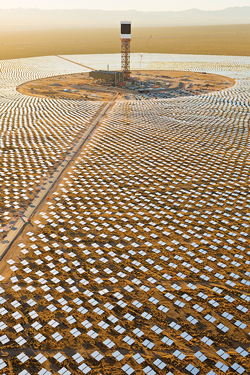|
These are rough times, of late, for bureaucrats’ environmental agendas. First, as reported by our Capitals page contributor, Øystein Noreng (see page 25 for details), Europe’s mad dash to everything “green” at any cost is faltering, thanks to the European Parliament (EP). The EP’s refusal to approve a cut in emission quotas for sale, thereby cutting out the legs from under carbon prices, is a stinging indictment of the green policies pushed by Brussels-based bureaucrats.
 |
The Ivanpah solar project blankets the Mojave Desert. Photo courtesy of BrightSource Energy, Inc.
|
|
Coincidentally, the executive director of the International Energy Agency (IEA), Maria van der Hoeven, had just complained in an annual report to the Clean Energy Ministerial (CEM) that “The drive to clean up the world’s energy system has stalled.” Yet, consider the great progress made by the U.S. in reducing emissions (thanks to natural gas). The IEA, itself, reported last year that U.S. emissions dropped from their 2011 levels, and were down 7.7% since 2006. Similarly, the U.S. DOE reported that carbon emissions in first-quarter 2012 were at their lowest point in two decades. Last month, the U.S. EPA dramatically lowered its estimate, by 20%, of methane leaks during natural gas production. EPA said that tighter emission controls put into place by industry from 1990 through 2010 have cut average U.S. methane emissions more than 850 million metric tons, overall.
Most U.S. citizens haven’t heard about these numbers, because the green lobby, its friends in the White House and their national media disciples don’t want the public to know. The numbers are under-reported, because they were achieved by gas (a fossil fuel) instead of wind and solar.
Tortoises versus mirrors. The idiocies of governmental energy policy mixed with environmental ideology are not limited to parts of Europe—consider the Mojave Desert in southeastern California. Most folks living in the Mojave choose to do so, because: 1) they don’t want to live in cities; and 2) they want to be left alone, without any big industrial projects in their backyards. So, they are incensed at the encroachment of large-scale solar power projects, driven incessantly forward by a federal government hell-bent on fulfilling a “clean energy” agenda.
At first, everything seemed fine, until: 1) conservationists realized that solar projects threatened a number of endangered species, like desert tortoises, bighorn sheep and lizards; and 2) former Secretary of the Interior Ken Salazar began fast-tracking solar and wind projects on thousands of acres of public lands. The conservationists are trying to stop the march of these projects and have enlisted Sen. Dianne Feinstein (Dem.-Calif.) to help. In turn, Feinstein has filed a bill in Congress called the California Desert Protection Act, to try to protect more land from solar/wind development. So, we now have fights going on between people that all call themselves “environmentalists.” There is the fight between the U.S. Fish and Wildlife Service, which is trying to protect endangered species, and the Bureau of Land Management, which wants to develop those species’ lands for “clean energy.” There also is the fight between Feinstein, representing California’s residents and physical assets, and her own party’s President, who is shoving green energy projects down the public’s collective throat.
At the center of this mess is the Ivanpah solar generating project, a 377-MW solar facility owned by NRG Solar, Google and BrightSource Energy, on track to begin operating this year. It features BrightSource’s solar thermal tower technology, which uses thousands of mirrors in circles on the ground to focus the power of the sun on solar receivers, or boilers, atop power towers.
The companies and federal officials say that the project “covers” 3,500 acres, or 5.5 sq mi, of public land, or only 0.5% of the Mojave’s land, but that’s just one project. Four other projects (26,600 acres) are already approved, plus another eight (47,600 acres) under review and awaiting approval. So, if all 13 projects are built, at least 77,700 acres, or 11.1%, of the Mojave will be covered up with solar facilities. Ironically, environmentalists complain that oil and gas fields are ugly and ruin the landscape. But I dare say that no oil or gas field so thoroughly covers up so much land at one time as these facilities do, as shown in the photo on this page.
Gas tax follies. Yes, the federal and state governments are looking to tax even more money out of Americans’ pockets, to cover “shortfalls” in funds needed to fix roads and bridges, and build mass transit. At least four states had, at press time, approved gasoline tax increases, including California, Wyoming, Vermont and Maryland, with another 12 states considering hikes.
Nationwide, there are calls to increase the current 18.4 cents/gal federal gasoline tax and also tie it to inflation—yes, more money for the White House to waste. Meanwhile, another money-wasting institution, the International Monetary Fund (IMF), has stated that it would like to see Americans taxed $1.40 more per gallon of gasoline, as a means of getting people to drive less, thereby preventing global warming and saving the environment. Considering the IMF’s checkered record of results and money wastage, these are the last people who should be telling the U.S. how to allocate funds. 
|





